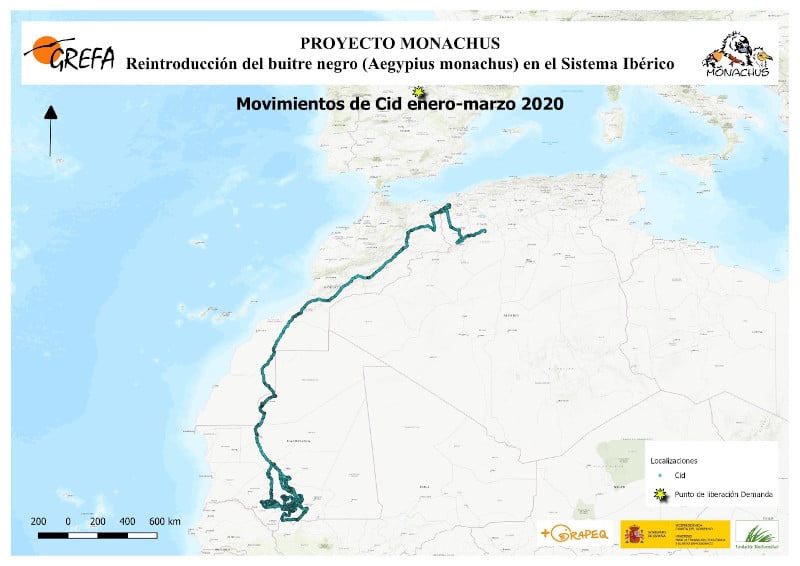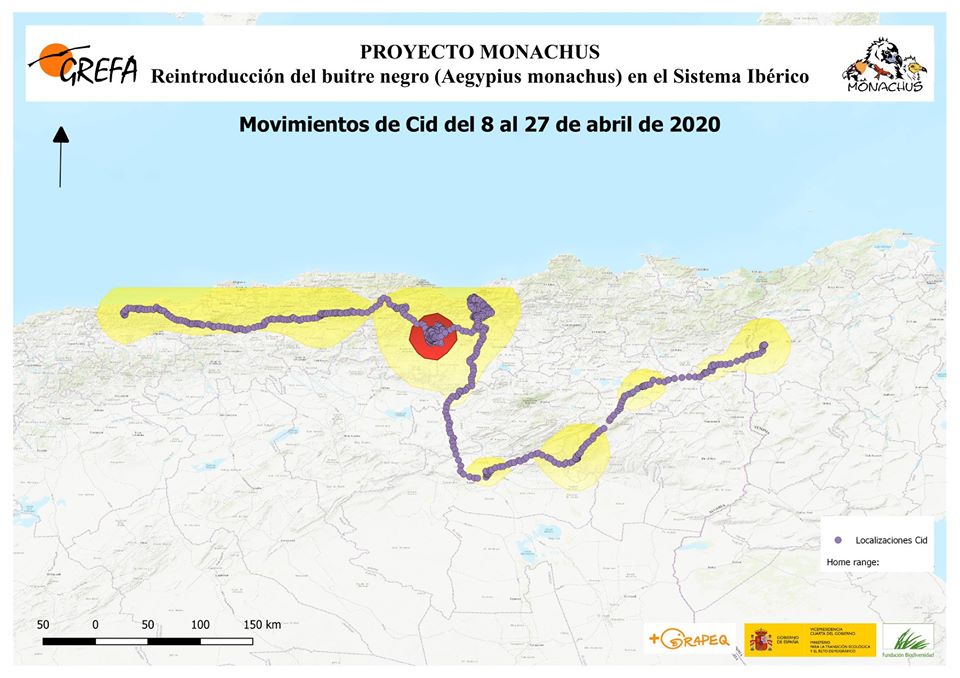Two satellite-tagged Cinereous Vultures (Aegypius monachus) from France and Spain have been tracked to Africa. One has reached as far south as the Niger-Nigeria border, while the other is touring northern Africa after having first spent the winter in the Sahel area.
These are the first individuals GPS-tracked in their breeding areas in Europe to have reached Africa. The two vultures were tracked by LPO and GREFA respectively and the following summarises their great journeys.
While the Cinereous Vulture is a regular winter visitor in Morocco in small numbers, it’s still rare in West Africa (For example, the first for Mauritania was only recorded in 2017 and the first for the Gambia was in 2018).

From France to the Niger-Nigeria border area
The juvenile Cinereous Vulture ‘Xylophone’ was equipped with a GPS tag by the LPO in August 2019 in the Grands-Causses, Aveyron, France. (The Cinereous Vulture went extinct in France as a breeding species in the beginning of the 20th century. In 1992, LPO and its partners started the reintroduction of the species in the Grands-Causses).
On 24 October, two months after fledging, this young male leaves the Causses. He crossed the Pyrenees from the Col de Perthus on 25 October, and crossed Spain very quickly along the Mediterranean coast.
On 8 November, he arrived at the Strait of Gibraltar which he crossed in about twenty (22) minutes; he continues his journey south to Tazekka National Park, where he spends his first night on the African continent.
The next day, 9 November, he continued the journey to the Southeast. However, the GPS tag stopped transmitting data on 14 November when the young vulture arrived at the gates of the Sahara not far from Tamanrasset in southern Algeria. After three weeks without satellite data, new signals transmitted on 04 December when the vulture was on the borders between Niger and Nigeria (Sokoto region).
This is very likely the first record of the species for Nigeria.

Two months after taking off, this young vulture traveled 6,151 km (cumulative daily data). As of 13 February 2020, no GPS data were received to know its fate; but there is still hope to receive new GPS data.
Big thanks to Renaud Nadal from LPO (Programmes Nationaux de Conservation / Grands-Causses) who sent me the details above in email on 16 March. But because the COVID-19 pandemic, I wasn’t able to publish it earlier. In fact, the last time I published in the website was on 12 March (about the satellite-tagged Pallid Harrier ‘Selja’ that died in southern Morocco).
From Spain to Mauritanian and back to North Africa
The juvenile Cinereous Vulture ‘Cid’ was born in April 2019 in the captive breeding centre of GREFA in Majadahonda near Madrid.
In early September, it was transferred to the ‘Proyecto Monachus’ facilities in the Sierra de la Demanda, located in the Burgos province, northern Spain. And on 6 October, it was released along with twelve other Cinereous Vultures. (The ‘Proyecto Monachus’ aims to reintroduce the Cinereous Vultures to the Sistema Ibérico mountain range (Burgos province) where the species went extinct in the middle of the 20th century).
After spending the first few weeks in the release area, Cid started to move south on 31 October. After reaching southern Andalusia, he stayed twelve days in the province of Cádiz.
On 24 November, Cid crossed the Strait of Gibraltar, and five days later he reached the desert areas in south-east Morocco. By the time he is already in Algeria, on 3 December, the GPS transmitter stopped transmitting the signals. However, the GPS tag started to transmit again when Cid had managed to cross the Sahara desert. He is now in its wintering area in Mauritania.

After its wintering time in the Sahel is up, Cid started the northward migration on 28 February 2020. Unlike the autumn migration, this time Cid used a more westerly route from Mauritania until the Souss region, and then it deviated to a northeasterly route until the extern north-east of Morocco.
To the surprise of the GREFA team, the young vulture instead of going towards the Strait and then back to Spain, he veered towards the east. After entering Algeria, Cid started dispersing first south to the Saharan Atlas and then east again (shown in the map below). He continued these zigzagging movements (interrupted by different stops) while continuously moving towards the east. During his travel across Algeria, Cid made one of the largest known non-stop flights by a Cinerous Vulture according to GREFA: 361 km.

The surprises of Cid won’t end here though, because his eastwards movement leads him all the way to Tunisia which he reached on 27 April (He travelled some 24 Km deep inside the Tunisian territory when he stopped for the night).
This is the second record of the species for the country (The first was recorded on 27 March 1991 at Jebel Zaghouan, and mentioned in the Birds of Tunisia. Thanks Hichem Azafzaf for the correction in the comments).

Is Cid going to over-summer in North Africa?
It would be very interesting to see if this young vulture will spend the summer in North Africa or go back to Europe later in the season.
Thanks to satellite tracking we know that some young birds of migratory long-lived raptors are summering in Northwest Africa after spending the winter in West Africa. For example, after spring migration immature Short-toed Snake Eagles spent the summer in Northwest Africa instead of heading to their European breeding areas.
Another example is the Egyptian Vulture. It’s well known that immature birds of this species spend the first few years in their wintering area in the Sahel before returning to their breeding areas. Summering in North Africa, however, has just been discovered. Three captive-born vultures released in Italy by ‘Associazione CERM’ and their partners spent their first years in Africa as usual. However, the surprise is that in their second year they moved northward to North Africa where they spent a few months before returning to Niger at the end of the summer. This migratory behaviour is yet to be discovered in wild-born Egyptian Vultures.
If Cid spends this summer in North Africa, it would be a first for his species.
Update: no summering this time
Cid the Cinereous Vulture only stayed 3 full days in Tunisia. After reaching the country on 27 April, he travelled north and then south. He left Tunisia towards the west at the latitude of Chott el Djerid on 1 May (see the map below where each colour represents the journey made in a single day).

After entering Algeria on 1 May, he quickly traveled across the country in 4 days to reach Morocco. Once here, he continued along the northern Rif region where he spent the night of 6 May (end of map below).
On 7 May, he continued towards the Strait of Gibraltar which he crossed on the same day. Here ends the long African journey of this young vulture. See you next year maybe!
Fascinating stuff ! 😃
Thanks!
Congratulations for this work and thank you for this article. Please note that the first record of Monk Vulture for Tunisia was on 27 March 1991 at Jebel Zaghouan, this is the second observation.
Hichem Azafzaf
Coordinateur du Programme Scientifique
Association “Les Amis des Oiseaux” Partenaire de BirdLife en Tunisie
Thanks for correction!